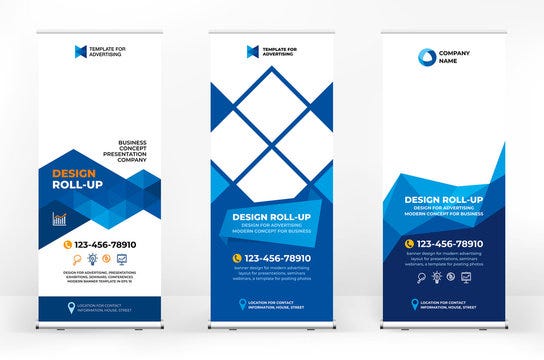Comprehensive Guide to Designing Standee Banners
Standee banners are versatile marketing tools used to capture attention and convey messages effectively in various settings, from trade shows and exhibitions to retail stores and corporate events.

A well-designed standee banner can make a significant impact, drawing potential customers and enhancing brand visibility. This comprehensive guide will walk you through the essential steps to design a standee banner that stands out and communicates your message effectively.
Understand Your Purpose and Audience:
Before diving into the design process, it’s crucial to clearly understand the purpose of your standee banner and identify your target audience. Ask yourself:
- What message or information do you want to convey?
- Who is your target audience, and what are their preferences and interests?
- What action do you want your audience to take after viewing the banner?
Choose the Right Size and Orientation:
Standee banners come in various sizes and orientations, including vertical and horizontal formats. Consider the space where the banner will be displayed and choose a size and orientation that maximizes visibility without overwhelming the surroundings. Common sizes for standee banners include 24" x 70", 33" x 80", and 36" x 92".
Create a Compelling Design Concept:
A compelling design concept is the foundation of an effective standee banner. It should be visually appealing, easy to understand, and aligned with your brand identity. Here are some tips for creating a compelling design concept:
- Use high-quality images and graphics that resonate with your target audience.
- Incorporate your brand colors, logo, and typography to maintain consistency.
- Keep the design clean and uncluttered to ensure readability from a distance.
- Use contrasting colors to make important elements stand out.
- Consider incorporating a catchy headline or tagline to grab attention.
When designing a standee banner, it’s essential to prioritize key information and present it in a clear and concise manner. Determine the most important messages you want to convey and ensure they are prominently featured on the banner. This may include:
- Your company name and logo
- A brief description of your products or services
- Contact information, such as website, phone number, or social media handles
- Any special offers, promotions, or call-to-action statements
Typography plays a crucial role in the readability and overall impact of your standee banner. Choose fonts that are legible from a distance and reflect your brand personality. Avoid using too many different fonts, as this can create visual clutter. Instead, stick to one or two fonts for consistency. Additionally, pay attention to font size and spacing to ensure that text is easy to read even from afar.
Use Eye-Catching Graphics and Images:
Incorporating eye-catching graphics and images can help attract attention to your standee banner and reinforce your message. Whether you use photographs, illustrations, or icons, make sure they are relevant to your brand and message. High-quality images with vibrant colors and clear details are more likely to grab the viewer’s attention and leave a lasting impression.
White space, also known as negative space, is the empty space around design elements. Incorporating white space into your standee banner design helps improve readability and visual appeal by giving the viewer’s eyes room to breathe. Avoid overcrowding the banner with text and graphics, and instead, use white space strategically to create balance and emphasis.
Consider the Viewing Distance:
Since standee banners are often viewed from a distance, it’s essential to consider how your design will appear from afar. Make sure that key information is legible from a distance and that important elements are prominently positioned to catch the viewer’s eye. Test your design by viewing it from various distances to ensure readability and effectiveness.
Once you’ve finalized your standee banner design, it’s crucial to optimize it for printing to ensure the best possible results. Here are some tips for optimizing your design for printing:
- Set your document dimensions to match the size of the banner.
- Use high-resolution images and graphics to prevent pixelation.
- Convert text to outlines to avoid font compatibility issues.
- Check color mode and ensure it’s set to CMYK for accurate color reproduction.
- Leave a bleed area around the edges to prevent trimming errors.
Before sending your standee banner design to print, take the time to review it carefully for any errors or inconsistencies. Double-check spelling, grammar, and alignment to ensure a polished final product. If possible, gather feedback from colleagues or friends to get a fresh perspective on your design. Iterate as needed until you’re confident that your standee banner is ready for printing and display.
Conclusion: Designing a standee banner requires careful planning, creativity, and attention to detail. By following the steps outlined in this guide, you can create a compelling and effective standee banner that attracts attention, communicates your message, and enhances your brand visibility.

Remember to keep your audience in mind throughout the design process and continuously strive for clarity, simplicity, and impact. With the right approach, your standee banner can become a powerful marketing asset that drives engagement and generates results.
Comments
Post a Comment